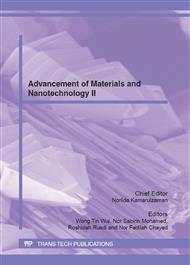[1]
Miller, D., Device requirements for optical interconnects to silicon chips. Proceedings of the IEEE, 2009. 97(7): pp.1166-1185.
DOI: 10.1109/jproc.2009.2014298
Google Scholar
[2]
Reed, G., et al., Silicon optical modulators. Nature Photonics, 2010. 4(8): pp.518-526.
Google Scholar
[3]
Gan, F., et al., Design of all-optical switches based on carrier injection in Si/SiO/sub 2/split-ridge waveguides (SRWs). Lightwave Technology, Journal of, 2006. 24(9): pp.3454-3463.
DOI: 10.1109/jlt.2006.880157
Google Scholar
[4]
Juthika, B., et al., Developments in gigascale silicon optical modulators using free carrier dispersion mechanisms. Advances in Optical Technologies, 2008. (2008).
DOI: 10.1155/2008/678948
Google Scholar
[5]
Reed, G. and A. Knights, Silicon Photonics. 2005: Wiley Online Library.
Google Scholar
[6]
Xu, Q., et al., Micrometre-scale silicon electro-optic modulator. Nature, 2005. 435(7040): pp.325-327.
DOI: 10.1038/nature03569
Google Scholar
[7]
Hewitt, P. and G. Reed, Improving the response of optical phase modulators in SOI by computer simulation. Lightwave Technology, Journal of, 2002. 18(3): pp.443-450.
DOI: 10.1109/50.827519
Google Scholar
[8]
Hewitt, P. and G. Reed, Improved modulation performance of a silicon pin device by trench isolation. Lightwave Technology, Journal of, 2002. 19(3): pp.387-390.
DOI: 10.1109/50.918892
Google Scholar
[9]
Barrios, C., V. de Almeida, and M. Lipson, Low-power-consumption short-length and high-modulation-depth silicon electrooptic modulator. Lightwave Technology, Journal of, 2003. 21(4): pp.1089-1098.
DOI: 10.1109/jlt.2003.810090
Google Scholar
[10]
Marris-Morini, D., et al., Low loss and high speed silicon optical modulator based on a lateral carrier depletion structure. Optics Express, 2008. 16(1): pp.334-339.
DOI: 10.1364/oe.16.000334
Google Scholar
[11]
Green, W., et al., Ultra-compact, low RF power, 10 Gb/s silicon Mach-Zehnder modulator. Optics Express, 2007. 15(25): pp.17106-17113.
DOI: 10.1364/oe.15.017106
Google Scholar
[12]
Gan, F. and F. Kartner, High-speed silicon electrooptic modulator design. Photonics Technology Letters, IEEE, 2005. 17(5): pp.1007-1009.
DOI: 10.1109/lpt.2005.846756
Google Scholar


